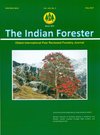Floral Biology and Breeding Behaviour in Terminalia belerica and Terminalia chebula
DOI:
https://doi.org/10.36808/if/2017/v143i5/114977Keywords:
Floral Biology, Breeding Behaviour, Terminalia belerica, Terminalia chebula.Abstract
Floral biology and breeding behaviour in 13 accessions of Terminalia belerica (10) and T. chebula (3), the two most important medicinal plants was studied. Floral bud initiation took place from 16 to 21 April in all the accessions of T. belerica and 2 to18 May in T. chebula. Flower opening started in the morning hours between 7 h to 8 h and maximum flower opening ranged from 54.8 to 85.7 % in T.belerica and 77.7 to 81.8 % in different accessions of T. chebula. Anthesis occurred between 8 to 9 am. Stigma was most receptive between 9 to 14 hrs approximately one hour after anthesis. Pollen size varied in different accessions and it was 18.45 μm to 22.23 μm in T. belerica and 15.40 to 17.5 μm in T. chebula. Pollination is by insects in both the species and main flower visitors observed were different species of insects (Apis indica, Chilomenes sexmaculata, Drosophilla melanogaster, Solenopsis geminate and Carpophilus hemipterus) and honey bee (Apis indica) is the chief pollinator. No fruit setting was observed in covered flowers. Self incompatibility was observed in both species. The fruit setting under open pollinated condition showed wide variation in different accessions of T. belerica (3.4 to 7.6%) and T. chebula (5.8 to 7.4 %). It took 209-222 days for fruit maturity in T. belerica and 231-241 days in T. chebula. The fruit drop varied from 16.6 to 44.4 % in T. belerica and 25-30 per cent in T. chebula in different accessions.References
Alexander M.P. (1969). Differential staining of aborted and non aborted pollen. Stain Technol., 44:117-122.
Alexander M.P. (1987). A method for staining pollen tubes in pistil. Stain Technol.,62 (2):107- 112.
Anon. (1976). The Wealth of India. Raw materials. Vol. X.sp-w. Publication and Information Directorate. CSIR. New Delhi.
Arthi H.S., Ganeshaiah K.N. Uma Shankar R. and Hegde S.G.(1999).Seed abortion in Pongamia pinnata ( Fabaceae) Am. J. Bot., 86:659-662.
Bawa K.S. (1 974). Breeding systems of tree species of a low land tropical community. Evolution, 28:85-92.
Bawa K.S. and Webb C.J. (1984). Flower, fruit and seed abortion in tropical forest trees: Implications for the evolution of paternal and maternal reproductive patterns. Am. J. Bot.,71:736-751.
Dhillon R.S., Hooda M.S., Ahlawat K.S. and Kumari S. (2009). Floral biology and breeding behaviour in Karanj (Pongamia pinnata L. Pierre). Indian Forester, (5):618- 627.
Ghate V. and Kumbhojkar M.S. (1991). Phenology of deciduous ornamental trees from western Maharashtra. Ind. J. For., 14(3):181-189.
Gargi Kumar R., Deka M., Yadav H. and Sahay A.( 2015). Crossability studies in Terminalia arjuna and T. tomentosa. Int. J. Appl. Biol. Pharh. Technol., 6(3):211-216.
Hooker J.D. (1878). The flora of British India. Bishen Singh Mahendra Pal Singh. Dehradun. India.
Lloyd D.G. and Webb C.G.(1986). The avoidance of interference between the presentation of pollen and stigmas in angiosperms. 1. Dichogamy. N.Z.J. Bot.,24:135-162.
Michael David K. , Lakshmi Padmavati P., Sai Ram Reddy P., Lakshmi S.S. and Rama Gopal G.( 2012). Studies on the reproductive and pollen biology of Terminalia arjunaW&A (Comberetaceae).Int. J. Appl. Biol. Pharm. Technol., 3(2):291-296.
Michael David K.(2016). Reproductive and pollen biological studiesof Terminalia bellerica Roxb.(Combretaceae). Indian J. Research, 5(5):583-585.
Richards A.J. (1994). Plant breeding systems. New York: Chapman and Hall.
Sankanur M., Singh N.B., Thakur S., Thakur Sapan, Saresh N.V. and Verma Archna (2014). Studies on floral biology and breeding system of Terminalia chebula Retz.An important tree species of India and South East Asia. Journal of International Academic Research for multidisciplinary,2 (7):19-37.
Solomon Raju A.J. and Rao S.P. (2006).Pollination ecology and fruiting behaviour in Acacia sinuate (Lour). Merr.(Mimoceae), a valuable nontimber forest plant species. Curr.Sci., 82(12):1466-1471.
Suryanarayana N., Kumar R. and Gargi (2005). Monograph on Indian tropical Tasar silkworm food plants (Terminalia spp.). Central Tasar Research and Training Institute, Ranchi, Jharkhand, India.72-73.
Sutherland S.(1986). Floral sex ratio, fruit set and resource allocation in plants. Ecology, 67:991-1001.
Talwar S. and Bhatnagar A.K. (2014). Pollen biology of Terminalia chebula Retz. In Delhi and Western Ghats. International. J. Plant Reproductive Biology, 6(2): 181-194.
Thangaraja A. and Ganesan V. (2008). Studies on the pollen biology of Terminalia paniculata Roth. (Combretaceae). African J. Plant Sci., 2(12):140-146.
Vasudeava S.P. and Sareen T.S. (2011). Reproductive biology of Dalbergia sissoo Roxb. Indian Forester, 137 (4):411-426.
Weir R.J. and Zobel B.J. (1975). Advanced generation of seed orchards. Forestry Commotion Bulletin, 54:118-127.
Wheelan R.J. and R.L. Goldingay (1989).Factors affecting seeds in Telopea speciossima : The importance of pollen limitation. J. Ecol., 77:1123-1134.
Downloads
Downloads
Published
How to Cite
Issue
Section
License
Unless otherwise stated, copyright or similar rights in all materials presented on the site, including graphical images, are owned by Indian Forester.





